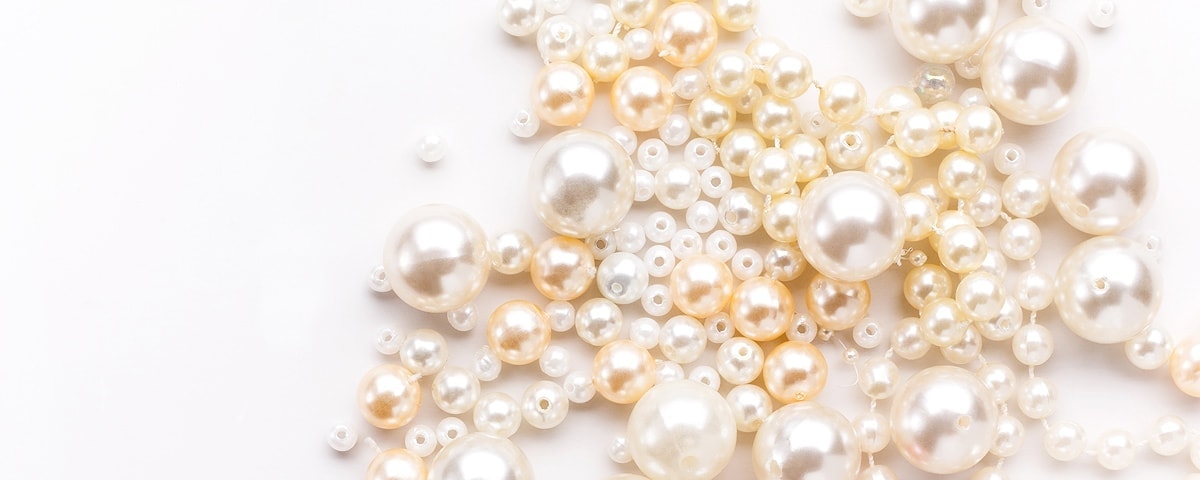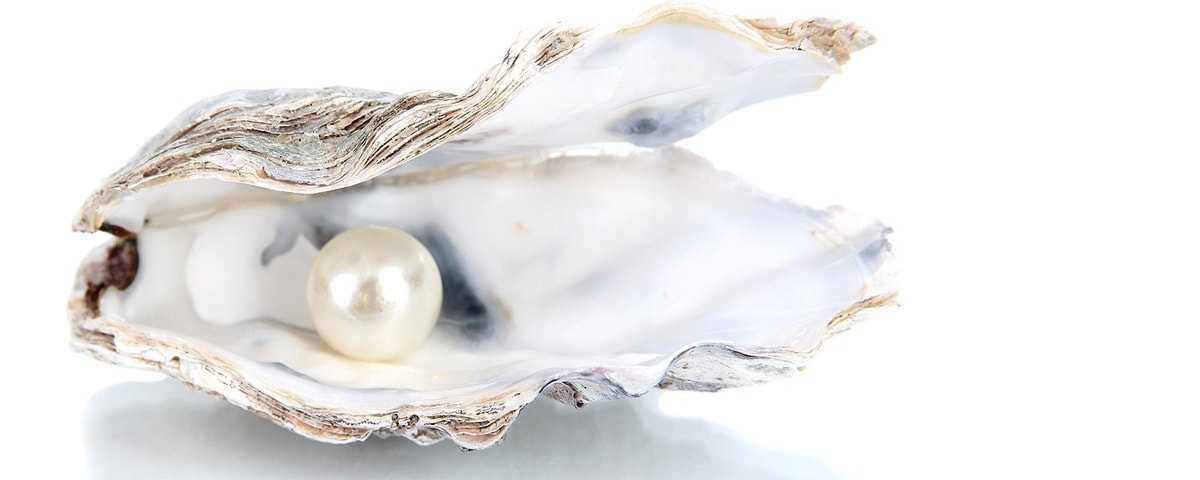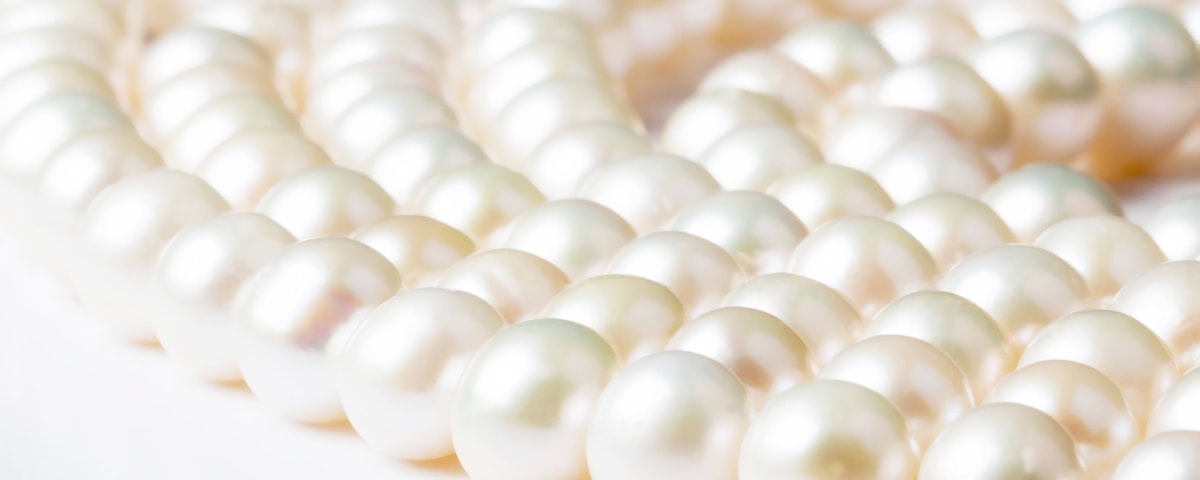Quite possibly the most popular gem of all time, pearls have been sought out to create beautiful jewelry for many years. Pearl jewelry comes in the form of matching pearl earrings, single pearl rings, full strings of magnificently matching pearl necklaces, and more.

Unique among the precious gems, pearls are organically-grown in living creatures. They occur when a mussel or oyster gets a foreign particle caught in its sensitive tissues. The creature protects itself against the particle by coating it in concentric layers of a hard, lustrous material, gradually forming a pearl.
What are Pearls Made From?
Oysters and mussels form pearls out of the same substance that makes up the inside of their shells. This substance is known as nacre, or mother-of-pearl. Nacre comes in many forms, depending on the particular species that it comes from, which makes up for the different colors and qualities of different varieties of pearl. However, the primary component is generally aragonite (CaCO3). Nacre also contains a small amount of a horn-like substance called conchiolin, which is used by the mollusk to produce its outer shell.
Variation in Pearls
Though most people instinctively imagine the same, perfectly round and perfectly white variety of pearl when they think of the gem, there is a rich spectrum of variety to be found among pearls. Pearls come in many different shapes, types, and quality levels.
Another consideration when it comes to pearls is the difference between natural and cultured pearls. Natural pearls are the ones found in nature, whereas cultured pearls have been cultivated by pearl farmers.
Pearl Shapes
Pearls come in more than just the classic sphere shape. Since there are many variables that affect pearls as they grow, there is a great variety of pearl shapes available. Some shapes are rarer than others, so the shape of a pearl is one of the big deciding factors in the value of a piece of pearl jewelry.
There are seven basic pearl shapes, which fit into three main categories.
These shapes are as follows:
Spherical Pearls
- Round: These are the perfectly spherical pearls. Round pearls are highly prized for their rarity and their classic aesthetic.
- Near-Round: A near-round pearl has some tiny flaw that prevents it from being perfectly spherical. Though they can generally pass for round under casual observation, they might be slightly elongated or flattened.
Symmetrical Pearls
- Oval: These pearls are distinctly oblong in shape.
- Button: Button pearls are flattened enough that they take on a disk-like appearance. A common choice for earrings.
- Drop: When a pearl takes on a pear or teardrop shape, it is categorized as a drop pearl. Drop pearls come in either “long” or “short” varieties, depending on the specific proportions of the pears. Popular for earrings and pendants.
Baroque
- Baroque: When a pearl develops while lodged in tough muscle fibers, it can take on an irregular, non-symmetrical shape. They were prized during the Renaissance, who appreciated the unique nature of each individual baroque pearl.
- Semi-Baroque: The semi-baroque pearls are the ones that just barely miss being qualified as symmetrical. They have some flaw that prevents them from being perfectly symmetrical, but are not as irregular as a straight baroque pearl.
Ringed Pearls
Some pearls develop grooves or rings that encircle their surface. When this happens, the pearl is known as either “ringed” or “circled”. Pearls of any shape can be ringed; a round pearl with rings is labeled as a “ringed round”, for example, while a drop pearl with a ring is known as a “ringed drop”.
Natural Pearls vs Cultured Pearls
When shopping for real pearl jewelry, you have two options: natural pearls and cultured pearls. Natural pearls are found in nature, while cultured pearls are fostered within pearl farms that recreate the conditions under which pearls occur in nature.

It’s important to recognize that cultured pearls are not the same as imitation pearls. Imitation pearls are made of cheap materials like plastic or glass, whereas cultured pearls are made of the same material as natural pearls. Pearl farmers instigate the pearl-forming process by planting a tiny core made of mussel shell into an oyster or mussel, and then the oyster or mussel forms a pearl around it in the usual way.
There are several key differences between natural pearls and cultured pearls, which affect the price range and qualities of the pearls:
Price Differences
It’s quite difficult to find natural pearls, and even more difficult to find natural pearls in a desirable shape. It is for this reason that natural pearl jewelry has become rare. A perfect strand of natural pearls is all the more rare, and may be among the most expensive pieces of jewelry.
Since cultured pearls are farmed, they can be made more available at far lower prices than natural pearls. However, particularly high quality or desirable cultured pearls can still be quite valuable. You can therefore expect to find cultured pearls in a wide variety of prices.
Features
Though both kinds of pearls grow in largely the same way, the available features among natural and cultured pearls are quite different. Since cultured pearls can be cultivated to suit the wishes of consumers, they can be specially shaped into popular, uniform styles. At the same time, they can also be treated with dyes or bleaches as they develop in order to achieve high-quality luster or special coloration that may not be found in nature.
Natural pearls, on the other hand, can be found in asymmetrical, irregular shapes. These are not widely appreciated, but they have historically been prized for their natural, singular nature.
Quality Factors of Pearls
The value of a piece of pearl jewelry is largely affected by the quality of the pearls themselves. When gauging the value of pearls, it is important to consider many factors, these being the size, shape, color, luster, surface quality, nacre thickness, and the matching quality.

Unfortunately, there is not one single, industry-wide standard system for grading the quality of pearls. There are two widely accepted systems, these being the AAA-A system and the A-D, or Tahitian system. The AAA-A system ranks pearls from highest to lowest quality by labeling them AAA, AA, or A. The Tahitian system instead labels the highest quality pearls A, following this with B, C, and D for progressively lower-quality pearls. When shopping for pearls, it pays to inquire about the system that your particular jeweler uses to rank its pearls.
Size
Since pearls are grown organically, larger pearls take more time to form. It is therefore that, with all other qualities being equal, a larger pearl is going to be more valuable than a smaller one.
The size of a pearl is given in millimeters, which represent the diameter of the gem. Even a single millimeter of difference between pearls can entail a great increase in both the appearance and price of the pearl. The average pearl is going to be between 6.5 and 7 millimeters.
Shape
Though the common image of a pearl is that of a perfectly round sphere, these are actually quite rare. Pearls come in many different shapes, from the round to the teardrop to the downright irregular. The quality of a pearl’s shape is based on the rarity and desirability of the shape, with the perfect spheres representing some of the most expensive.
Color
Pearls come in a full spectrum of colors, from white to black. This color is divided into three key components: the body color, the overtone, and the orient. The body color represents the pearl’s dominant color, the overtone comes in the form of a translucent hue that lies on top of the body color, and the orient is the color visible just below the pearl’s surface. All pearls have a body color, but not every pearl features an overtone or orient.
The value of a given pearl can be linked to the rarity and demand for its color, as well as the presence or absence of a pleasing overtone or orient.
Luster
A pearl’s luster refers to its ability to reflect light. The highest quality pearls should clearly show you your own reflection on its surface. The lowest quality luster will feature a dim and diffused reflection.
Surface Quality
The surface area of a pearl is most often marred with some sort of imperfection, be it a scratch, a wrinkle, or a flattened section. The fewer flaws that a pearl has, of course, the higher its value is going to be in relation to similar pearls.
Nacre Thickness
Also known as mother of pearl, nacre is the substance that makes up the shell of a pearl. The thicker the pearl’s nacre, the greater its luster and durability.
The thickness of a pearl’s nacre is only an issue for saltwater, bead-nucleated pearls. Freshwater pearls and keshi pearls are composed of solid nacre.
Matching
This is a quality that only comes into play in jewelry pieces that feature multiple pearls. On a pearl necklace, for example, it is generally more desirable for all pearls to be of similar size, shape, color, and luster.
Since it is far more difficult to find matching pearls in nature, a piece of natural matching pearl jewelry can be exponentially more expensive than a cultured equivalent.
Pearl Facts
Because of the rarity of naturally occurring pearls, a process of cultivating pearls was introduced in the early 1900s. In this process, a small bead of polished shell is inserted into an oyster or mollusk to act as an irritant and produce a pearl, which can take up to 24 months. These pearls are referred to as cultured pearls. Pearls are classically elegant and never go out of style.
Types of Pearls
Akoya
These pearls were the first type of pearl to be cultured. Japan and China are the main producers of these pearls. They are consistently round, which makes them perfect for strands. Colors range from white to cream, though some can be gray or black.
Freshwater
The freshwater pearl is usually slightly less round, smaller in size, and possesses less luster than other varieties of saltwater pearls. These pearls are usually cultivated in China and provide a value-priced option.
Instead of growing inside an oyster or mollusk like other pearls, the mabé pearl actually grows against the shell of the oyster, creating a dome-shaped pearl. This pearl is harvested, then assembled. The nucleus is removed and replaced by resin, while mother-of-pearl is used to cover the flat back. Mabés traditionally have high luster and lower prices than round pearls.
South Sea
These pearls are cultured in the northern waters of Australia, Indonesia, and the Philippines. These pearls are considerably larger than Akoya pearls and much more sensitive during the cultivation process. South Sea pearls are naturally white, cream, or golden in color.
Tahitian
These pearls are slightly smaller than the South Sea pearl, but are also sensitive during the cultivation process. The colors of black, silver, and gray occur naturally and they are cultured in Tahiti as their name implies.



